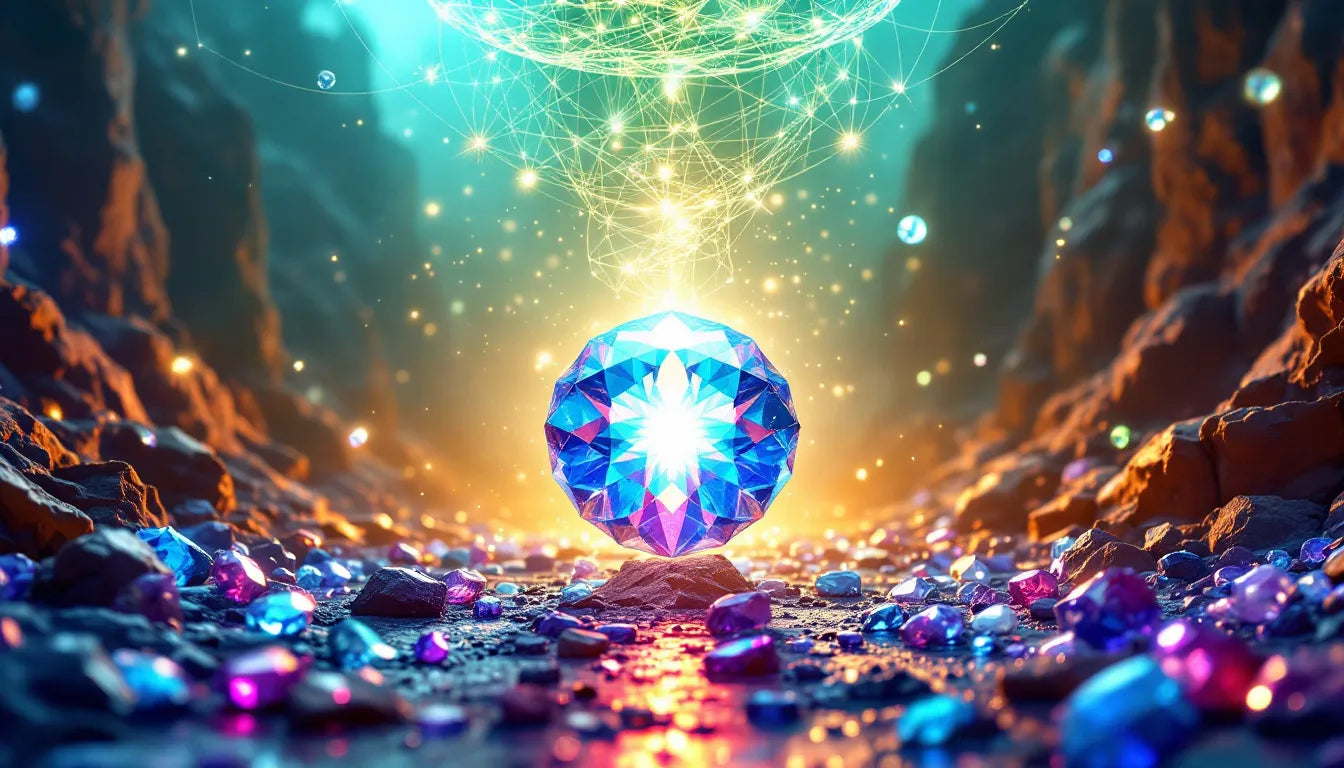Blockchain is revolutionizing the gemstone industry by creating a digital trail for each stone from mine to market. Here's what you need to know:
- Blockchain provides an immutable digital record for gemstones
- It tackles issues like authenticity verification and ethical sourcing
- Major players like De Beers and Everledger are already using blockchain
- The technology benefits miners, manufacturers, retailers, and customers
Key benefits of blockchain in gemstones:
| Benefit | Description |
|---|---|
| Transparency | Tracks gemstone journey from source to sale |
| Authenticity | Verifies gemstone origin and characteristics |
| Efficiency | Streamlines transactions and supply chain |
| Trust | Builds consumer confidence in ethical sourcing |
While only 3% of companies currently use blockchain at scale, experts predict widespread adoption by 2025. As the technology improves, it's set to become the new standard in gemstone tracing, boosting transparency and trust across the entire supply chain.
Related video from YouTube
How blockchain solves gemstone industry problems
Blockchain is fixing big issues in the gemstone world. Here's how:
Supply chain transparency
Blockchain lights up the gemstone journey:
- Each stone gets a unique blockchain ID
- Real-time updates track the stone's location
- Everything's out in the open - no hiding shady stuff
TrustChain, used by Richline Group and Helzberg, tracks gems from start to finish.
Spotting real gems
Blockchain helps fight fakes:
- Real stones get digital twins on the blockchain
- Info can't be changed once it's there
- Buyers can check a stone's history in seconds
Everledger uses blockchain to make sure diamonds and other precious stones are legit.
Smoother supply chains
Blockchain doesn't just track - it streamlines:
| Old Way | Blockchain Way |
|---|---|
| Paperwork | Digital records |
| Slow checks | Quick lookups |
| Manual updates | Auto updates |
| Hard to trace | Easy to follow |
De Beers Group's Tracr platform shows how it's done, tracking diamonds and boosting trust.
Blockchain isn't just tech talk for gemstones. It's making the industry more honest and efficient. As more companies jump on board, we'll see even bigger changes in how gems move from mine to market.
Ways to use blockchain for gemstone tracing
Blockchain is shaking up gemstone tracking. Here's how:
Digital tokens for gemstones
Each gem gets a unique digital token on the blockchain. This token:
- Stores all gem info
- Can't be altered
- Proves ownership
Tiamonds, for instance, uses Ethereum tokens for diamonds. Each token includes LCX and GIA certificates, verifying authenticity.
Smart contracts for transactions
Smart contracts streamline gem deals:
- Automate payments
- Remove middlemen
- Lower costs
- Enforce quality standards
Walmart uses similar tech for pork tracking in China. Customers scan QR codes to see their meat's journey.
Real-time gemstone tracking
Blockchain offers live gem tracking:
| Old Way | Blockchain Way |
|---|---|
| Paper records | Digital updates |
| Delayed info | Real-time tracking |
| Limited access | Open to all parties |
Provenance Proof does this for colored gems, logging each stone's journey with photos and docs.
Blockchain in action
1. De Beers' industry-wide platform
De Beers is rolling out a blockchain system to track diamonds. CEO Bruce Cleaver states:
"It's a huge public ledger as immutable as anything invented. It's a much more un-hackable system than anything on a single server."
2. Everledger's diamond tracking
Since 2015, Everledger has used blockchain to combat diamond fraud, recording each stone's unique features.
3. Provenance Proof Marketplace
This platform connects gem traders directly. Since 2019, it's registered 700 users and processed over 5 million gems.
Blockchain is making the gem industry more transparent. As adoption grows, we'll see bigger shifts in gem trading.
Who benefits from blockchain in gemstones
Blockchain is shaking up the gemstone industry. Here's who's winning:
Miners and suppliers
Blockchain lets miners and suppliers prove their gems are legit. They can:
- Show when and where gems are mined
- Prove they're not cutting corners
- Track gems from mine to market
Fura Gems is using blockchain for their Colombian emeralds and Mozambican rubies. Vikram Pathak from Fura says:
"We're tracking every single movement of these stones around the world and know exactly where they are going."
This tracking helps miners get better prices.
Manufacturers and processors
Gem cutters and jewelry makers win too. They can:
- Check where their gems come from
- Log their work on each stone
- Show off their skills
Retailers and jewelers
Stores selling bling get these perks:
- Prove their stuff is real
- Show customers the gem's whole story
- Build trust with buyers
De Beers, selling 35% of the world's diamonds, launched a blockchain system to track their rocks. It helps them prove their diamonds are real and ethical.
Customers
Buyers get the best deal:
- Know their gem's backstory
- Check if it's ethically sourced
- See the gem's full journey
| Old Way | Blockchain Way |
|---|---|
| Mystery gem origin | Full gem history |
| Possible fakes | Verified real deal |
| Limited info | Detailed gem journey |
Blockchain makes gem buying crystal clear. It's building trust in the gem market.
sbb-itb-d0b3b91
Nora Sermez Jewelry and blockchain

About Nora Sermez Jewelry
Nora Sermez Jewelry makes luxury, handmade fine gold jewelry. They're all about bespoke engagement rings, necklaces, and statement pieces. But here's the kicker: they use recycled materials and ethically sourced gemstones.
Using blockchain for ethical sourcing
Nora Sermez isn't just talking the talk. They're using blockchain to walk the walk on ethical sourcing. Here's what that means:
- They can track gemstones from mine to market
- They verify where each stone comes from
- They prove their sourcing is ethical
With blockchain, customers can see exactly where their gemstones have been. It's all about transparency and staying true to their ethical, sustainable roots.
Customer stories and blockchain
Blockchain isn't just for sourcing. Nora Sermez uses it to make each piece special for their customers. How? Let's break it down:
1. Gemstone history
Each piece comes with a digital record. It's like a passport for your gemstone, showing everywhere it's been.
2. Custom design process
Customers can watch their piece come to life. From sketch to final product, it's all there on the blockchain.
3. Authenticity verification
Worried about fakes? Don't be. Blockchain lets customers check their jewelry's authenticity anytime.
| Feature | Benefit |
|---|---|
| Gemstone tracking | Keeps sourcing ethical |
| Design process logging | Gets customers involved |
| Digital certificates | Proves it's the real deal |
Nora Sermez is using blockchain to change the game in luxury jewelry. It's not just about looking good - it's about feeling good about what you're wearing, too.
What's next for blockchain in gemstone tracing
Blockchain tech in the gemstone world is evolving fast. Here's what's coming:
New technologies on the horizon
- DNA-based nanoparticles
Gemfields and Gübelin Gem Lab have a new trick up their sleeve. They're using tiny DNA particles that stick to rough emeralds at the mine. These particles survive all the usual gem treatments, making it possible to trace emeralds back to their source.
- NFTs join the game
Non-Fungible Tokens are now being used to link sealed gem containers to digital tokens. This makes it easier for importers to track a gem's journey from mine to market.
This system is already making waves. It's the first blockchain platform that maps a gemstone's entire journey. About 9 million gemstones are registered on it, with 700 companies from over 50 countries taking part.
Will everyone use blockchain?
Not yet, but we're getting there. Here's where we stand:
- Only 3% of organizations use blockchain at scale
- 10% have a pilot program
- 87% are still in early testing stages
But change is coming fast. Experts think blockchain could be everywhere in supply chains by 2025.
For wider adoption, we need:
- Clear benefits and ROI for companies
- Better cooperation across the supply chain
- Smooth interoperability between different blockchain systems
- Meeting growing consumer demand for gem origin info
The future of blockchain in gemstone tracing looks promising. As the tech improves and more companies jump on board, it's likely to become a standard in the industry. This means more transparency, better traceability, and increased trust for everyone from miners to customers.
Wrap-up
Blockchain is shaking up the gemstone industry. It's making gem tracking and authentication a whole lot easier.
Here's the deal with blockchain and gemstones:
- It creates a digital paper trail for each gem
- It helps prove a gem's authenticity
- It streamlines gem transactions
Some big players are already on board:
- Everledger tracks diamonds from mine to market
- De Beers uses Tracr to prove conflict-free diamonds
- Richline Group's TrustChain follows gold and diamond journeys
This tech is a win for everyone in the gem game:
- Miners can prove ethical sourcing
- Jewelers can guarantee authenticity
- Customers get peace of mind
Take Nora Sermez Jewelry, for example. They're using blockchain to ensure ethical sourcing, giving customers a clear view of their jewelry's origins.
But blockchain isn't everywhere yet. The current breakdown:
- 3% of companies are heavy users
- 10% are in the testing phase
- 87% are just starting to explore
Experts predict wider adoption by 2025. To get there, we need:
1. Clear business benefits
Companies need to see the value in blockchain adoption.
2. Industry collaboration
The gem trade needs to work together to make blockchain effective.
3. Interoperable systems
Different blockchain platforms should be able to communicate.
4. Consumer demand
More customers need to ask about gem origins.
As blockchain tech improves and spreads, it's likely to become standard in the gem industry. This could boost trust across the entire gem supply chain, from miners to consumers.
FAQs
What is the blockchain for gemstones?
Blockchain for gemstones is a digital tracking system. It records a gem's journey from mine to market. Think of it as a gem's digital passport.
Here's what it does:
- Creates a tamper-proof record
- Tracks origin, characteristics, and ownership
- Uses a decentralized ledger with cryptographic security
Why it matters? It tackles big industry issues:
- Proves authenticity
- Traces ethical sourcing
- Cuts down on fraud
Will blockchain help the jewelry industry?
You bet. Blockchain is shaking up the jewelry world. It's tackling two major headaches: counterfeiting and lack of transparency.
How it's helping:
- Builds trust
- Streamlines supply chains
- Makes following regulations easier
Leanne Kemp, Everledger's CEO, puts it well: "Saying it's so, doesn't make it so." In other words, the industry needs PROOF. And that's exactly what blockchain brings to the table.
Can we trace gemstones?
Tracing gemstones isn't perfect. We can't pinpoint a colored stone to a specific mine. But blockchain? It's a game-changer for validating a stone's country of origin.
What blockchain can do:
- Log every supply chain transaction
- Store data on stone characteristics
- Link to certification docs
Take De Beers, for example. They use Tracr, a blockchain platform, to ensure their diamonds are conflict-free. It tracks the whole journey - from mine to jewelry store.


Leave a comment